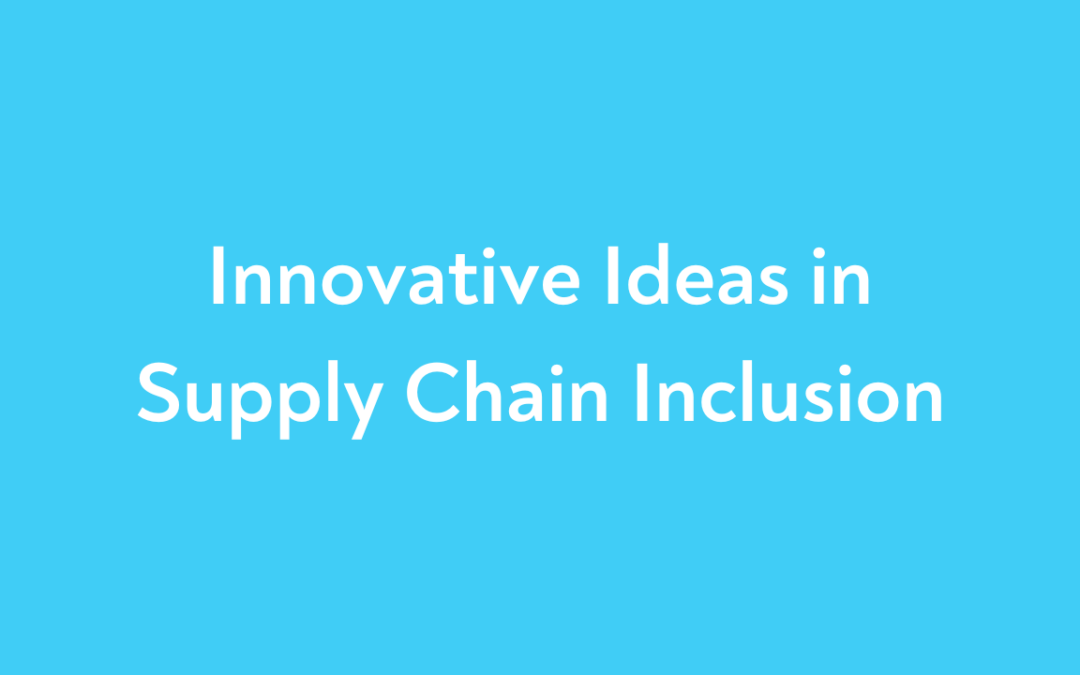Supply chain inclusion, also referred to as supplier diversity, is at the forefront of business innovation. As the corporate world shifts its focus to building more diverse and inclusive processes, the need for supply chain inclusion has become more apparent, fueling innovations like never before.
In this guide, we’ll explore how supply chain inclusion is changing traditional practices, how to implement inclusive procedures, and how supply chain inclusion is linked to global sustainability.
Here’s what we’ll cover:
- Innovations in Supply Chain Inclusion
- The Role of Technology in Supply Chain Inclusion
- Implementing Supply Chain Inclusion Innovations
- Changing the Language around Supplier Diversity and Inclusion
- Diverse Business Accreditation for the 21st Century
- Explaining Supplier Diversity to the World
- Linking Supplier Diversity to ESG Goals
- How Supply Chain Diversity Can Aid in Combating Climate Change
How New Innovations are Shaping Supply Chain Inclusion
From reimagining the traditional supplier relationship to leveraging new business models, disruptive innovations are reshaping supply chain inclusion across a variety of industries. Through technology, data analytics, and strategic partnerships, businesses are consistently finding new ways to generate and foster inclusive procurement practices.
- Energy & Utilities: [Link to article: “Disruptive Innovations Shaping Supply Chain Inclusion in [Energy]”]
- Construction: [Link to article: “Disruptive Innovations Shaping Supply Chain Inclusion in [Construction]”]
- Food & Beverage: [Link to article: “Disruptive Innovations Shaping Supply Chain Inclusion in [Food & Beverage]”]
- Entertainment: [Link to article: “Disruptive Innovations Shaping Supply Chain Inclusion in [Entertainment]”]
Powering Inclusion: The Role of Technology
The digital revolution has had a profound impact on supplier diversity management. Advanced technologies like AI and big data are enabling companies to connect with diverse suppliers, improve decision-making, and create more inclusive business ecosystems. Software solutions like Hire Ground offer an integrated platform that bridges the gap between corporate buyers and diverse suppliers, helping businesses align their procurement practices with their diversity and inclusion goals.
Link to article: “The Role of Technology in Driving Supply Chain Inclusion”]
From Ideas to Action: Implementing Supply Chain Inclusion Innovations
Innovative ideas alone aren’t enough to facilitate supply chain inclusion — they must be put into action. There are several strategies for implementing these innovations, from fostering a culture of inclusion within the organization to leveraging technology and forming key partnerships.
[Link to article: “How to Implement Innovative Ideas in Supply Chain Inclusion”]
Shaping Terminology in Inclusion and Supplier Diversity
Many procurement professionals are advocating for a shift in the terms we utilize in the diversity space. Renaming “supplier diversity” to “supply chain inclusion” emphasizes the holistic nature of inclusive procurement and underlines the importance of integrating diverse suppliers into every aspect of supply chain management.
[Link to article: “It’s Time to Rename Our Work: From Supplier Diversity to Supply Chain Inclusion”]
Rethinking Diverse Business Accreditation
The traditional model of diverse business certification has served an important role in promoting supplier diversity. However, in the modern era, there is a need for a new, flexible, and comprehensive model that allows diverse businesses to more easily and effectively acquire their certifications.
[Link to article: “The 21st Century Requires a New Model for Diverse Business Certification”]
Explaining Supplier Diversity on a Global Stage
As more businesses form global relationships with one another, there is a rising need to explain and promote the concept of supplier diversity on the international stage. American businesses can and should strive to clearly communicate the importance of supplier diversity with their international counterparts, and offer insights and perspectives on how supply chain inclusion can be made better on a global scale.
[Link to article: “An American Explains Supplier Diversity to the Rest of the World”]
The Link Between Supplier Diversity and ESG Goals
In recent years, ESG (Environmental, Social, and Governance) criteria have become a critical focus for businesses worldwide. Supplier diversity is inherently tied to these ESG goals, offering a practical way for organizations to demonstrate their commitment to social responsibility and sustainable growth.
[Link to article: “Yes. Supplier Diversity is Part of ESG”]
How Supply Chain Diversity Can Combat Climate Change
Supply chain inclusion has emerged as a powerful tool in the fight against climate change. By fostering diverse and inclusive supply chains, companies can engage a wider range of innovative, sustainable solutions and play a part in mitigating the impacts of climate change.
[Link to article: “The Power of Supply Chain Inclusion in the Fight Against Climate Change”]
The landscape of supply chain inclusion is ever-evolving, driven by innovative ideas and new approaches. By embracing these changes and committing to creating inclusive business ecosystems, companies can position themselves at the forefront of their industries and contribute to a more equitable, sustainable future.


Recent Comments